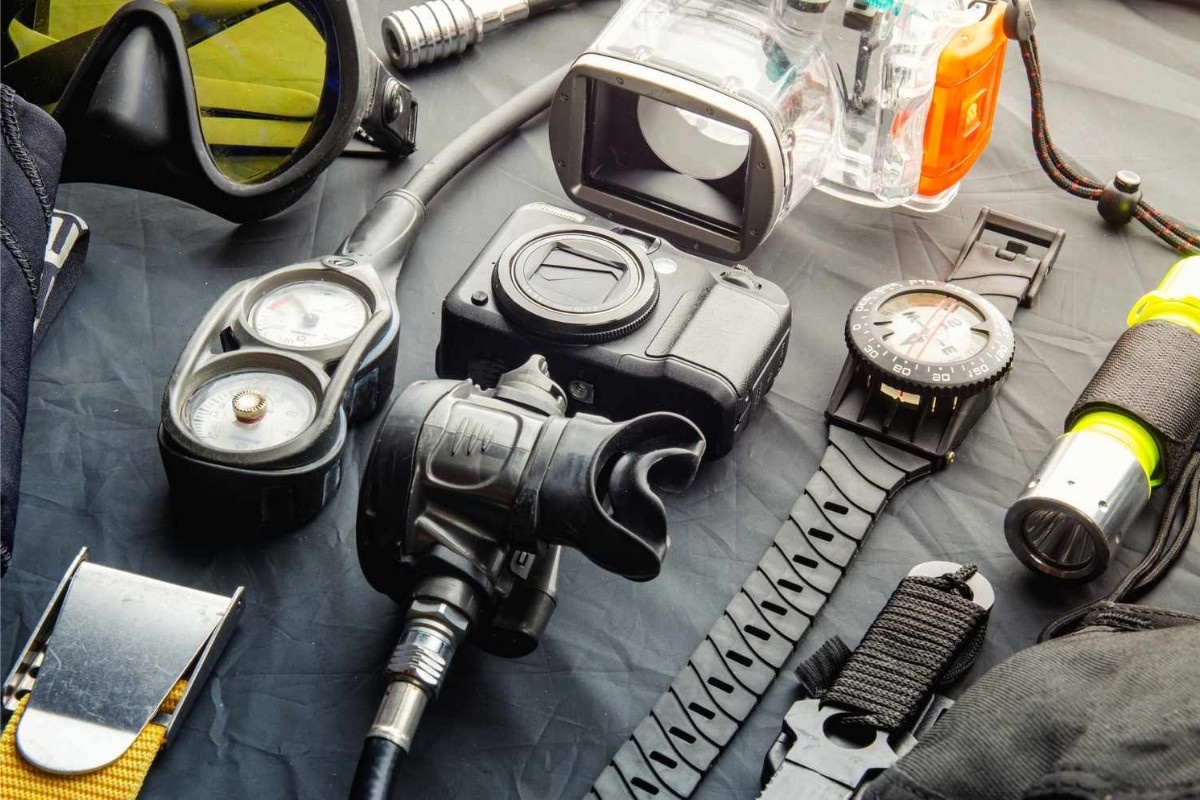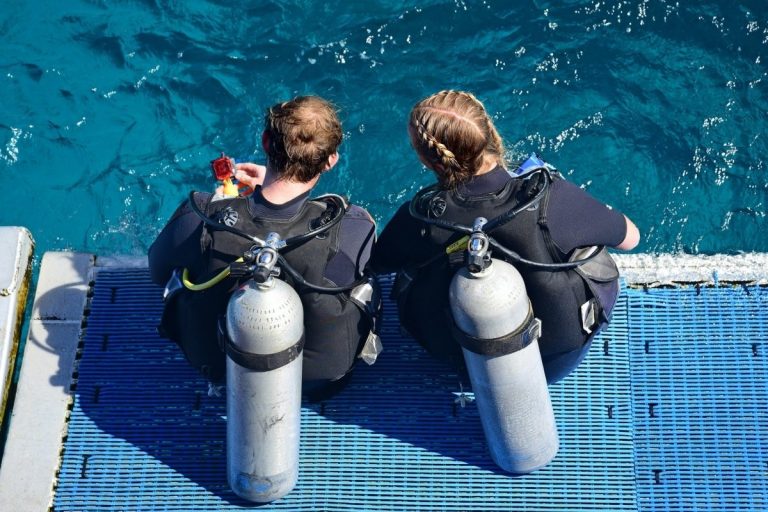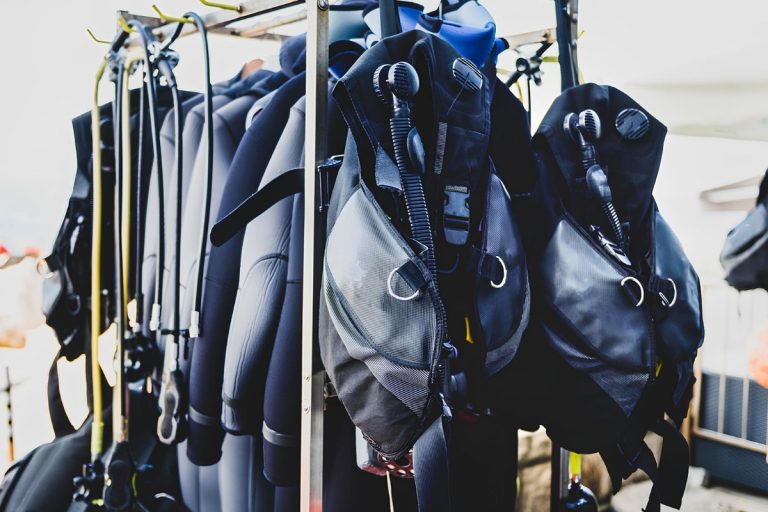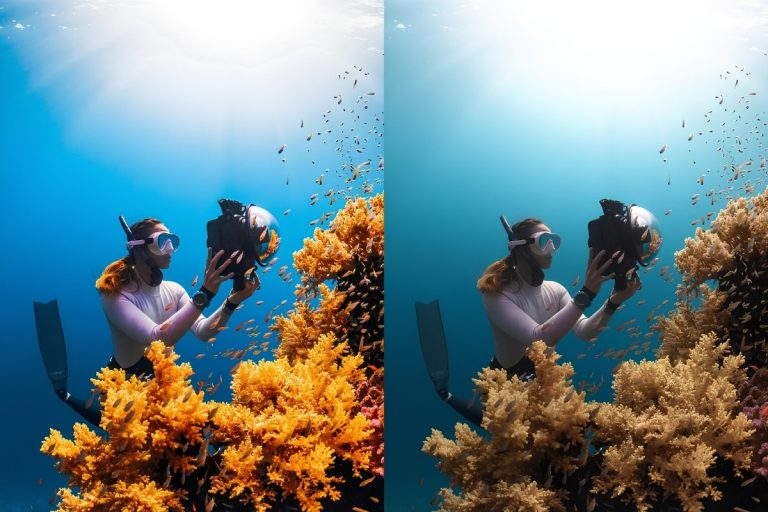Getting Started with Your Diving Accessory Collection
Overview of Essential Accessories
When you’re planning your next underwater adventure, having the right accessories can make the difference between a good dive and an extraordinary one. Beyond your basic scuba diving gear basics like masks, fins, and regulators, there are three critical accessories that every serious diver should consider: knives, lights, and surface marker buoys. These tools aren’t just nice-to-have additions to your kit; they’re safety essentials that can help you navigate challenging situations underwater.
Each of these accessories serves a specific purpose in your diving toolkit. A quality diving knife helps you cut through entanglements and can serve as a useful tool for various underwater tasks. Proper lighting equipment ensures you can see clearly in darker environments and communicate effectively with your dive buddy. Surface marker buoys provide crucial safety benefits by marking your location to boats above and helping you maintain proper ascent procedures.
Importance of Choosing the Right Gear
Selecting quality accessories requires careful consideration of your diving style, experience level, and typical diving conditions. Just like troubleshooting your regulator requires understanding its components, choosing accessories means understanding how each piece fits into your overall diving system. The wrong accessory can create more problems than it solves, while the right one becomes an invaluable part of your underwater experience.
Quality matters significantly when it comes to diving accessories. Cheap alternatives might seem appealing initially, but they often fail when you need them most. Investing in reliable, well-made accessories from reputable manufacturers ensures your gear will perform consistently in various underwater conditions and last for many diving seasons.
Diving, Snorkeling, and Freediving Gear
Different types of underwater activities require different accessory considerations. Scuba divers typically need more comprehensive lighting systems and larger knives, while freedivers might prefer streamlined, lightweight options that don’t create drag. Snorkelers often benefit from simpler accessories that enhance their surface-oriented activities without adding unnecessary complexity.
Understanding these differences helps you make informed decisions about which accessories to prioritize. A technical diver exploring deep wrecks has vastly different lighting needs compared to a recreational diver enjoying shallow reef dives. Similarly, the knife requirements for someone cutting fishing nets differ from those needed for general underwater tasks.
Brands to Consider for Accessories
The diving industry features several trusted manufacturers known for producing reliable accessories. Companies like Aqualung, Cressi, Mares, and ScubaPro have built reputations on creating gear that performs consistently in demanding underwater environments. These brands invest heavily in research and development, ensuring their products meet the rigorous demands of serious divers.
When evaluating brands, consider factors like warranty coverage, availability of replacement parts, and the company’s reputation within the diving community. Established brands often provide better customer support and have extensive dealer networks, making it easier to service or replace your gear when needed.
Knives: A Diver’s Best Friend
Types of Diving Knives
Diving knives come in several distinct styles, each designed for specific underwater applications. Traditional diving knives feature straight, pointed blades ideal for precision cutting tasks and can serve as useful tools for prying or measuring. Serrated knives excel at cutting through tough materials like rope, fishing line, or kelp, making them popular among divers who frequently encounter entanglements.
Titanium knives offer superior corrosion resistance and lighter weight compared to stainless steel alternatives, though they typically cost more. Some divers prefer combination knives that feature both straight and serrated edges, providing versatility in a single tool. Line cutters and shears represent specialized options designed specifically for cutting through fishing line and nets with minimal effort.
Features to Look for in a Diving Knife
A quality diving knife should feature a corrosion-resistant blade that maintains its edge through repeated saltwater exposure. The handle must provide secure grip even with wet gloves, and the overall design should allow for easy one-handed operation. Look for knives with secure sheath systems that prevent accidental loss while allowing quick deployment when needed.
Blade length represents another important consideration. Longer blades provide more cutting power but can be cumbersome in tight spaces, while shorter blades offer better maneuverability but less leverage for tough cutting tasks. The ideal length depends on your typical diving conditions and personal preferences.
How to Properly Maintain Your Diving Knife
Proper maintenance starts immediately after each dive with thorough freshwater rinsing to remove salt, sand, and other debris. Pay special attention to the blade edge, handle grip areas, and sheath mechanism. Allow the knife to dry completely before storage to prevent corrosion and bacterial growth.
Regular sharpening maintains cutting effectiveness and actually extends blade life by preventing the need for aggressive resharpening later. Use appropriate sharpening tools for your blade material, and consider professional sharpening services if you’re uncomfortable doing it yourself. Apply a light coating of appropriate lubricant to moving parts and metal surfaces to prevent corrosion during storage.
Safety Tips for Using a Diving Knife
Always secure your knife properly to prevent loss and avoid creating hazards for other divers. Position the knife where you can reach it easily with either hand, but ensure it won’t interfere with your other equipment or catch on underwater obstacles. Practice deploying and using your knife in controlled conditions before relying on it in emergency situations.
Never use your diving knife as a prying tool beyond its design limits, as this can damage the blade or cause dangerous breakage. When cutting entanglements, work slowly and deliberately to avoid injuring yourself or your dive buddy. Always cut away from your body and other divers, and be aware of your surroundings to prevent accidentally damaging coral or marine life.
Lighting Gear: Illuminating Your Underwater World
Types of Underwater Lights
Primary dive lights serve as your main illumination source and should provide powerful, reliable lighting for extended periods. These lights typically feature high-output LED arrays, robust construction, and long battery life. Backup lights offer redundancy and emergency illumination, usually in smaller, more compact packages that are easy to carry and deploy quickly.
Specialty lights include red lights for preserving night vision, UV lights for fluorescent diving, and video lights for underwater photography. Strobe lights and markers help with signaling and location identification. Each type serves specific purposes, and many divers carry multiple lights to handle different situations and requirements.
Choosing the Right Light for Your Dive
Light selection depends heavily on your diving environment and intended activities. Deep diving requires more powerful lights with longer burn times, while shallow reef diving might prioritize compact size and ease of handling. Night diving demands reliable primary lights with adequate backup options, while day diving might only require simple backup lights for looking into crevices and overhangs.
Consider beam patterns when selecting lights. Wide flood beams illuminate large areas but don’t penetrate as far, while narrow spot beams provide long-distance visibility but limited peripheral illumination. Many modern lights offer adjustable beam patterns, providing versatility for different diving situations.
Battery Life and Maintenance Tips
Battery technology significantly impacts light performance and reliability. Rechargeable lithium-ion batteries offer excellent performance and environmental benefits, while disposable batteries provide convenience and reliability for infrequent use. Always carry spare batteries or backup lights for critical diving situations.
Monitor battery levels before each dive and replace or recharge batteries before they become critically low. Clean battery contacts regularly to ensure reliable connections, and remove batteries during long-term storage to prevent corrosion damage. Keep spare O-rings and lubricant available for maintaining waterproof seals.
LED vs. Halogen: Which is Better?
LED technology has largely replaced halogen bulbs in modern diving lights due to superior efficiency, longer life, and better durability. LEDs produce more light per watt of power consumption, resulting in longer battery life and cooler operation. They also resist shock and vibration better than traditional bulbs, making them ideal for the demanding underwater environment.
However, some divers still prefer halogen lights for specific applications where color rendering is critical. Halogen bulbs produce a warmer light spectrum that some photographers find more appealing for certain subjects. LEDs continue to improve in color quality, and most divers find modern LED lights perfectly adequate for all their underwater lighting needs.
Surface Marker Buoys: Your Safety Lifeline
What is a Surface Marker Buoy?
A surface marker buoy (SMB) is an inflatable signaling device that marks a diver’s position at the surface, providing crucial safety benefits for both the diver and boat traffic above. These devices typically consist of a brightly colored inflatable tube connected to the diver by a line, creating a visible marker that moves with the diver’s position underwater.
SMBs serve multiple safety functions beyond simple position marking. They help establish proper ascent rates by providing a visual reference for controlled ascents, and they can signal distress or request assistance in emergency situations. Many diving operations require SMB deployment as a standard safety procedure, particularly in areas with heavy boat traffic or strong currents.
How to Use a Surface Marker Buoy Effectively
Proper SMB deployment requires practice and attention to technique. Begin by partially inflating the buoy at depth using either exhaled air or a low-pressure inflator, then gradually release line as you ascend to maintain proper buoyancy and avoid rapid ascents. The key is maintaining control of both the SMB and your own buoyancy throughout the process.
Deploy your SMB well before beginning your ascent, ideally during your safety stop or while still at depth. This gives surface support time to locate your position and ensures you have a clear ascent path. Practice SMB deployment in controlled conditions until the process becomes second nature, as emergency situations leave little room for learning.
Different Types of Surface Marker Buoys
Delayed surface marker buoys (DSMBs) remain deflated until deployed, making them compact and easy to carry during the dive. Open-circuit SMBs can be inflated using exhaled air, while closed-circuit versions require low-pressure inflators or oral inflation. Some SMBs feature multiple chambers for redundancy and improved visibility.
Specialized SMBs include models with reflective strips for low-light conditions, extra-large versions for improved visibility, and models with built-in whistles or signaling devices. Choose an SMB appropriate for your typical diving conditions and local requirements, as some areas have specific regulations regarding SMB use and specifications.
Regulations and Best Practices
Many diving locations require SMB use as a mandatory safety measure, particularly in areas with heavy boat traffic or challenging conditions. Check local regulations and dive operation requirements before your trip, as non-compliance can result in diving restrictions or safety violations.
Best practices include carrying backup SMBs for redundancy, ensuring your SMB line is properly secured to prevent loss, and practicing deployment techniques regularly. Maintain your SMB properly by checking for leaks, ensuring inflation mechanisms work correctly, and replacing worn components as needed. Consider the visibility conditions and choose appropriately colored SMBs for maximum effectiveness.
Choosing the Right BCD
Understanding BCD Types
Buoyancy Control Devices come in several configurations that affect how you integrate and use your accessories. Jacket-style BCDs wrap around your torso and provide buoyancy through air chambers on the sides and back. Back-inflate BCDs position the air cell behind you, offering better swimming position and easier access to accessories mounted on your chest and sides.
Wing-style BCDs, popular in technical diving, feature separate wing units that attach to backplates and harness systems. This modular approach allows extensive customization for specific diving requirements and accessory integration. Each BCD style offers different advantages for carrying and accessing your essential accessories like knives, lights, and SMBs.
Impact of BCD on Accessory Use
Your BCD choice significantly affects how you carry and access your diving accessories. Jacket BCDs often provide multiple D-rings and attachment points integrated into the design, making it easy to secure knives, lights, and other gear. However, these attachment points may be less accessible when the BCD is fully inflated.
Back-inflate and wing BCDs typically offer more streamlined profiles that reduce drag and provide better access to chest-mounted accessories. The harness systems used with these BCDs often allow more customization for accessory placement, though they may require additional hardware for optimal gear integration.
BCD Features to Consider
Modern BCDs offer various features that enhance accessory integration and overall diving experience. Multiple D-rings provide secure attachment points for accessories, while integrated weight systems reduce the need for separate weight belts. Cargo pockets offer convenient storage for small accessories and backup equipment.
Quality construction materials resist corrosion and wear from saltwater exposure and repeated use. Look for reinforced stress points, quality zippers, and reliable inflation mechanisms. The BCD should fit properly and comfortably while accommodating your typical accessory load without creating balance issues or restricting movement.
How BCD Affects Diving Experience
A well-chosen BCD enhances your overall diving experience by providing stable buoyancy control and convenient accessory access. Poor BCD selection can create problems with trim, buoyancy control, and gear management that detract from your underwater enjoyment and potentially create safety issues.
Consider how your BCD integrates with your other equipment, including your regulator system, exposure suit, and accessories. The goal is creating a cohesive system where all components work together seamlessly. Test your complete gear configuration in controlled conditions before taking it on challenging dives.
Gear Care 101: Maintaining Your Accessories
Rinsing and Cleaning Your Gear
Thorough freshwater rinsing after each dive represents the most important step in accessory maintenance. Salt water, sand, and organic debris can cause corrosion, wear, and malfunction if left on your gear. Pay special attention to moving parts, threaded connections, and areas where different materials meet, as these locations are particularly susceptible to corrosion and wear.
Use lukewarm fresh water for rinsing, as hot water can damage seals and plastic components. Allow gear to soak briefly if heavily contaminated, then rinse thoroughly under running water. Don’t forget to rinse gear bags and storage containers, as salt buildup in these areas can recontaminate clean equipment.
Storage Tips for Diving Accessories
Proper storage protects your accessories from damage and extends their useful life significantly. Store gear in cool, dry locations away from direct sunlight and temperature extremes. Ensure all components are completely dry before storage to prevent mold, mildew, and corrosion. This is particularly important for items with fabric components or complex internal mechanisms.
Organize your accessories in dedicated storage systems that prevent damage from contact with other gear. Avoid storing knives with exposed blades where they might damage other equipment or cause injury. Keep batteries separate from electronic devices during long-term storage, and consider using desiccant packets in storage containers to control humidity.
Annual Servicing: Why It Matters
Professional servicing ensures your accessories continue performing reliably and safely. Many manufacturers recommend annual servicing for critical safety equipment, and some warranties require professional maintenance to remain valid. Professional technicians can identify wear patterns and potential problems before they cause equipment failure.
Annual servicing typically includes thorough cleaning, lubrication of moving parts, replacement of wear items like O-rings and seals, and testing of critical functions. Keep maintenance records for warranty purposes and to track the service history of your equipment. Budget for regular servicing as part of your overall diving expenses.
Common Mistakes in Gear Care
Many divers make preventable mistakes that shorten accessory life and compromise performance. Storing wet gear leads to corrosion and bacterial growth, while using inappropriate cleaning products can damage seals and finishes. Over-tightening threaded connections can damage threads, while under-tightening allows water intrusion and corrosion.
Neglecting manufacturer instructions for care and maintenance often voids warranties and leads to premature failure. Using accessories beyond their intended design limits causes accelerated wear and potential safety hazards. Regular inspection helps identify problems early, but many divers skip this crucial step until equipment actually fails.
Additional Gear Worth Considering
The Role of Fins in Diving
Quality fins significantly impact your diving experience and can affect how you use your other accessories. Proper fins provide efficient propulsion while maintaining good control and maneuverability. This efficiency reduces fatigue and air consumption, giving you more time to enjoy your dive and use your accessories effectively.
Different fin styles suit different diving activities and personal preferences. Open-heel fins with adjustable straps work well with boots and provide versatility for different conditions. Full-foot fins offer simplicity and efficiency for warm-water diving. Consider how your fin choice affects your overall gear system and accessory management underwater.
Importance of Masks and Snorkels
A properly fitting mask ensures clear vision for using your accessories effectively and safely. Mask problems like leaking or fogging can distract from proper accessory use and create safety hazards. Quality masks feature tempered glass lenses, comfortable skirts, and reliable strap systems that maintain their seal throughout the dive.
Snorkels provide surface breathing capability and emergency backup, though fixing snorkel leaks and maintaining proper function requires attention to seals and purge valves. Even divers who primarily use regulators benefit from carrying a simple snorkel for surface swimming and emergency situations.
Additional Safety Gear to Consider
Beyond the essential trio of knives, lights, and SMBs, several other accessories enhance diving safety and enjoyment. Dive computers provide crucial information about depth, time, and decompression requirements. Emergency signaling devices like whistles and mirrors can attract attention in distress situations.
Cutting tools beyond knives, such as line cutters and shears, provide specialized capabilities for specific entanglement situations. Reef hooks allow safe observation in current-swept areas, while underwater slates enable communication and note-taking during dives.
Accessories for Technical Diving
Technical diving often requires specialized accessories beyond recreational diving needs. Multiple backup lights become essential for deeper, longer dives where emergency ascent isn’t possible. Specialized cutting tools handle the heavier lines and equipment used in technical diving.
Advanced SMB systems may include lift bags for salvage operations and specialized markers for decompression stops. Technical divers often carry multiple knives for different purposes and backup equipment for critical safety functions. The complexity and redundancy requirements of technical diving significantly expand accessory needs and considerations.






